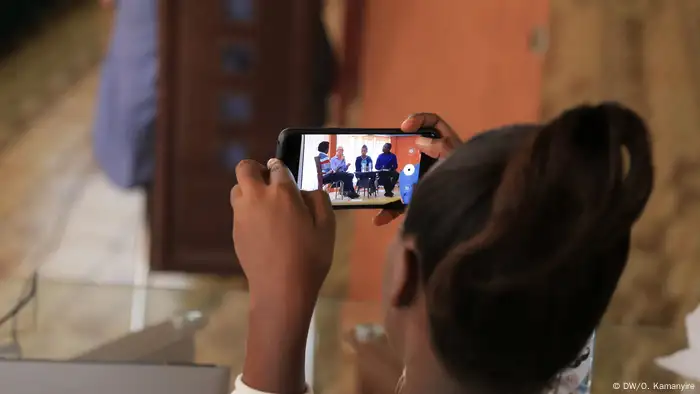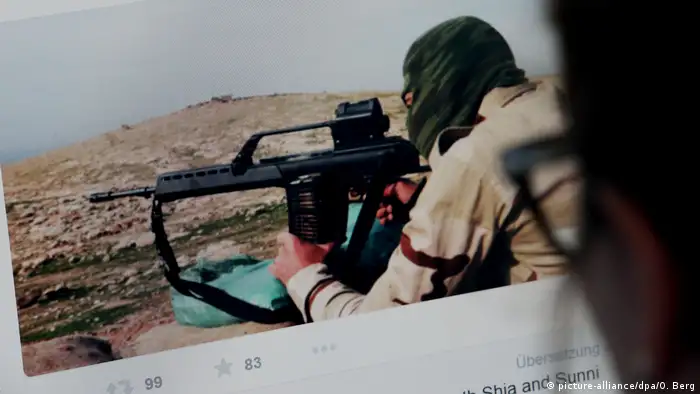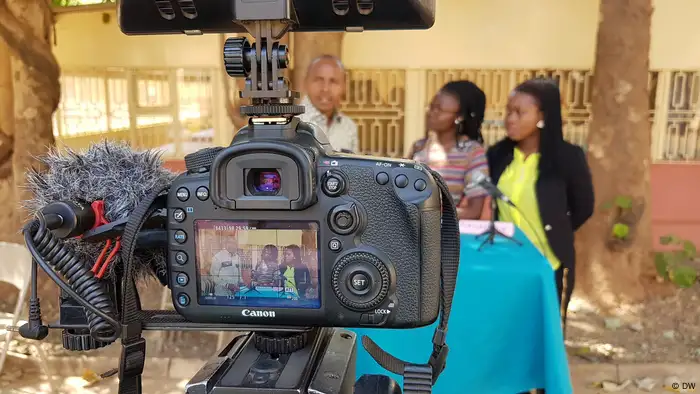Media development
Tackling online-radicalization: 7 steps to get started
Digital communication spaces are increasingly being misused to radicalize people - with major implications offline as well. What could media and development practitioners do to tackle this problem?

Participants of the Beyond Extremism Congress are being filmed in Kampala, Uganda, in November 2018.
In digitized societies around the globe, people can easily get trapped in radical narratives before even realizing what's happening. Radical groups approach their potential targets in their familiar spaces, sharing messages with manipulative sub-messages. The internet enables terrorists and extremists to communicate, collaborate and convince the masses in a way they would have never been able to do before, the US-based think tank Research and Development Corporation (RAND) found in a study.
Once one reacts, likes, shares or comments on something with a subtle radical connotation, for example on a picture of young woman standing in nature, wearing traditional clothes, tagged with hashtags like "patriotism", "homeland" or "tradition", you might start seeing more of the same and then more radical content.
And in social networks, every post and every member have connections, and connections with other connections, the so-called social graph. This social graph and the logic of algorithms is what lets users drift into new echo-chambers where the radical sub-message is widely shared.
The more often users hear a certain extreme message, the more they tend to believe it as their truth. They might also feel a sense of belonging, emotional connection and commitment to a new group. People may radicalize. This can have drastic effects on our offline world. A recent survey from the Australian Lowy institute found that digital communication and social media platforms can "support, encourage or mobilize real world harm." For instance in Christchurch in New Zealand or in Halle and Hanau in Germany: All three cities have been the scene for brutal right-wing attacks, that left dozens killed. What they also have in common is that the perpetrators shared their ideas and ideologies online, before committing real-life murders.
"The spaces of radicalization have moved from the back rooms of bookstores, onward to secretly exchanged DVDs and then to websites and messaging services such as Twitter and WhatsApp. A digitalized world produces digitalized terrorists," writes Linda Schlegel in a study for the German Konrad Adenauer Foundation.
For people to be aware of the dangers of online radicalization, a deeper understanding of how and where vulnerable groups are targeted by extremists is crucial.
What could people working in media development do to help citizens become more resilient to manipulation, echo-chambers and subtle online radicalization?
We were curious and wanted to find answers to this complex question. So, we looked into what others have been doing in this field, and what we could learn from them for our work. We read up on current scientific work in this field and asked internal and external experts about how to tackle online radicalization. Here we are sharing our seven findings about how to get started:
1. Focus and understand
Extremist narratives work so well and are very captivating because they pretend to provide simple answers to highly complex problems affecting our day to day lives. We all crave simple answers. It's a vulnerability extremists know how to exploit. People using digital communication tools should be aware of that.
The variety of digital spaces created for the sole purpose of accessing or recruiting "new people" for radicalization is huge. As huge as the different apps and tools of communication we use nowadays for shopping, chatting, entertainment or simply to kill time. Michael Krona has been researching online radicalization platforms for years. The expert on "Islamic State" ("IS") propaganda from Malmø university states that "'IS' for instance is active on up to about one hundred minor apps and platforms." So where to begin?
Krona emphasizes that it's important to study each individual micro-cosmos, in order to develop a "feeling" for what life and communication looks like in your targeted region: What are the most popular communication channels and how do they function? How are users reached there? And are those interactions used to facilitate radicalization? On the web, the content and distribution of messages are determined by the architecture and algorithms of the respective social media platform. So have a close look at the technology behind the communication in society and test it yourself so you understand it.
2. Understand "dark social" and be careful
There's nothing bad about "dark social" in general, even though the word "dark" can suggest it. "Dark social" refers to social media channels one can use privately, for example encrypted messenger apps, closed social media groups and other ways of private sharing. Those tools are popular because many people feel they are safer for sharing photos, texts or audios.
Some extremists are banned from bigger social platforms (deplatforming), with the side effect that they then move on to those encrypted and hidden channels, the German Amadeo Antonio Foundation found. In these closed or private groups, their messages don't get filtered, suppressed or hidden by algorithms, but immediately reach all members of the group. By effectively pushing radical views underground, a mechanism originally used to prevent digital radicalization might unintentionally encourage it, increasing the use of "dark social" by radical groups.
To get a better understanding of these channels and to understand current trends in online radicalization, media and development practitioners should study how they work.
However, when entering "dark" social spaces of radical groups or individuals as an investigator, one should be aware of the dangers and should take both digital and physical security measures, Krona says: "It exposes you and puts you at risk to be detected as a spy." He also warns of psychological stress. This is triggered not only by the risk of being discovered, but also by the fact that in digital spaces of radical groups, content is shared that is so disturbing that it can harm the mental health of the viewer.
3. Team up!
People use their digital devices very differently and have varying ways of communication - depending on their age, the region they live in or their education. To understand how online radicalization works in a specific region, team up with local partners.
Michael Krona says that preventive efforts must focus "on cooperation between practitioners, researchers, intelligence communities and religious/civil society – in order to educate more." They can share their insights; their in-depth analysis is crucial for any steps taken.
Local media companies could for instance be key to gaining insights and data for analysis. Monitoring social media can help build a better understanding of how these communication tools are being used in the region.
Another important step might be to team up with local deradicalization groups to better understand people's motivations and the issues they face, and to identify which groups are particularly vulnerable or which regions have a higher potential for radicalization.
4. Know the language and codes of radical groups
Face-to-face communication is less important to young people. They place a lot of trust in online contacts. Radical groups are well aware of this and produce professional-looking content, tactically planning what, where and how to communicate.
The tone and format of the messages disseminated are often familiar to what young people are used to consuming or producing themselves. As a result, they can easily be drawn in by it. As described earlier, after being hooked by seemingly harmless posts, people who join radical groups are increasingly exposed to a unique language of signs, codes and memes, designed to create connection and identity.
That's why it is crucial for anyone trying to get behind the logic of radicalization to dive deep into this language, know the codes in imagery, clothing or online communication used within the target group, says DW Akademie's Klaus Dahmann. After all, just as radical groups have learned to speak the language of the targeted audience, so should we learn theirs.
Dahmann has been working with YouTubers, young target audiences, media practitioners and other actors in the Western Balkan region for several years. "We aim to reach vulnerable groups and try to achieve that through positive and sometimes even humorous communication."
5. Build bridges to the offline world
Social media is an amplifier of existing conflicts in society, especially in regions with a history of violence. "Preventing extremism efforts must combine online and offline approaches, as extremism and radicalization are always a combination of the two", according to "IS"-expert Krona.
One possible approach to countering online radicalization is to create products or events with online and offline elements that engage people in constructive dialogue and approaches them in ways and through channels they are familiar with. Again, partner organizations with specialized knowledge may help to get the conversation started.

Events such as the Brave New Media Forum, hosted by DW Akademie in 2020, may contribute to a constructive dialogue on radicalization
6. Spread media, information, and digital literacy
If used without a deeper understanding, social media platforms may guide you into a limited information flow. To avoid information bubbles, which can be hard to leave, and to steer clear of the trap of radical narratives, people might want to improve their media and information literacy (MIL).
For example, MIL competencies that help people consume and produce media responsibly could range from understanding how social media works, with its algorithms and echo chambers, to mechanisms and effects of misinformation, disinformation and hate speech.
Also, supporting the introduction of school curricula focusing on MIL could help to counter attempts to radicalize young people through extremist propaganda and disinformation.
7. Advocate for change on a political level
To have a long-term impact, the problem of online radicalization also needs to be addressed at the policy level. For instance, when it comes to the big tech platforms' accountability. Here, many experts see a lack of regulation or self-regulation. According to Courtney Radsch, a journalist, author and freedom of speech advocate, the efforts of tech companies to prevent violent extremist groups from building a strong presence on their platforms are often too little too late: "That is a lesson the world learns again and again, but one that social media platforms refuse to acknowledge", says Radsch.
There are many entry points to advocate for change: The media and development community could further contribute to the discussion on meaningful social media regulation, build and exchange expert knowledge, bring together civil society and legislators, or participate in various forums such as the Internet Governance Forum or the global MIL week.
DW recommends
- Date 27.10.2021
- Author Carolina Machhaus, Julius Endert
- Feedback: Send us your feedback.
- Print Print this page
- Permalink https://p.dw.com/p/41Yq0
- Date 27.10.2021
- Author Carolina Machhaus, Julius Endert
- Send us your feedback.
- Print Print this page
- Permalink https://p.dw.com/p/41Yq0



